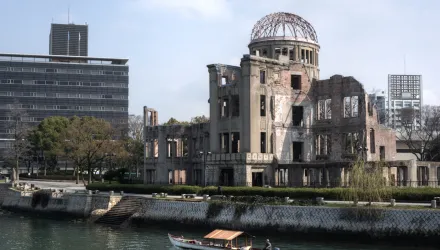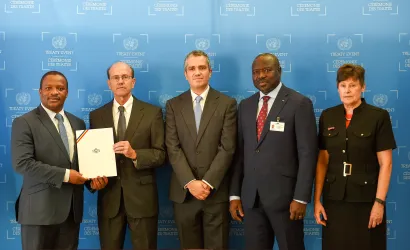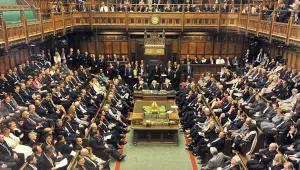This report has been produced in the interest of contributing to informed Congressional review and public discourse on a comprehensive nuclear agreement with Iran—the Joint Comprehensive Plan of Action (JCPOA). It provides a concise description of the agreement and the accompanying UN Security Council Resolution 2231. It also includes a balanced assessment of the agreement's strengths and weaknesses with respect to its central objective to prevent Iran from acquiring nuclear weapons. The team of experts who prepared the report includes Democrats, Republicans, independents, and internationals. Noting areas of disagreement among themselves, they agreed that this report provides an accurate description and balanced assessment of the agreement.
Contributors include Gary Samore (lead author and editor), Graham Allison, Aaron Arnold, Matthew Bunn, Nicholas Burns, Shai Feldman, Chuck Freilich, Olli Heinonen, Martin B. Malin, Steven E. Miller, Payam Mohseni, Richard Nephew, Laura Rockwood, James K. Sebenius, and William Tobey.
Download the Full Report »
Executive Summary
The Joint Comprehensive Plan of Action (JCPOA) is intended to stop Iran from acquiring nuclear weapons. If fully implemented, the physical constraints and verification provisions of this comprehensive nuclear agreement will effectively prevent Iran from producing fissile material for nuclear weapons at its declared nuclear facilities for at least 10 to 15 years. During this period, the provisions of the JCPOA—along with continuing national intelligence efforts—increase the likelihood of detecting any Iranian attempts to build covert facilities to produce fissile material, thus helping to deter Tehran from attempting to do so. Over 10 to 15 years, the physical constraints on fissile material production at declared facilities and most of the specialized verification and enforcement provisions of the JCPOA expire. At that point, Iran could expand its nuclear capabilities within a few years to create more practical options to produce fissile material for nuclear weapons, whether at declared or secret facilities. Actual production of nuclear weapons would violate Iran’s safeguards agreement with the International Atomic Energy Agency (IAEA), the JCPOA, and the Non-Proliferation Treaty (NPT). The agreement poses no restrictions on what the U.S. or other countries could do in that circumstance.
The central nuclear limits of the JCPOA are physical restrictions on Iran’s ability to produce fissile material for nuclear weapons (either separated plutonium or enriched uranium) at its declared nuclear facilities.[1]
The Plutonium Route
The physical limits on plutonium production in the JCPOA essentially close that pathway for the foreseeable future. The redesigned Arak heavy-water research reactor will not be able to produce large amounts of plutonium, its spent fuel will be shipped out of the country for the lifetime of the reactor, and Iran is not allowed to build additional heavy-water reactors or a reprocessing facility to separate plutonium from spent fuel for at least 15 years. Any Iranian attempt to secretly produce or divert plutonium from the Bushehr nuclear power plant would be quickly detected. Even after 15 years, when the ban on building new heavy-water reactors and a reprocessing plant becomes “voluntary” (i.e. Iran expresses the “intent” not to build such facilities), Iran would require years to build them. Although the Arak reactor will not be dismantled, it would require at least a few years to convert the reactor back to its original specifications and the effort would be easily detected.
The Uranium Route
The physical limits on enrichment at declared facilities in the JCPOA are less robust. While the agreement requires Iran to dismantle two-thirds of its installed centrifuges and eliminate 98% of its current enriched uranium stock, it permits Iran to retain a substantial uranium enrichment infrastructure and to begin to expand that infrastructure after 10 years. For 10 to 15 years, Iran will restrict the number and types of centrifuges installed and operating at Natanz, end enrichment at Fordow, limit research and development on advanced centrifuges, maintain a small stockpile of low-enriched uranium, and cap the level of enrichment. While these measures are reversible over a period of a few months to a few years, any reversal would be quickly detected.
Under these limits, “breakout time” at Natanz over the next decade would be extended to roughly a year, from the current estimated breakout time of 2 to 3 months.[2] From year 11 to year 15, breakout time at Natanz will decline as Iran is permitted to replace its first-generation centrifuges with limited numbers of advanced models, although the restrictions on enriched uranium stocks and enrichment level continue through year 15. Estimating breakout time during years 11 to 15 is difficult. The number and type of advanced centrifuges that Iran is permitted to deploy during this period is not public, and the performance of advanced centrifuge models under development is uncertain.
Some contributors to this report believe that breakout time by year 15 could be comparable to what it is today—a few months—while others believe it could be reduced to a few weeks. In any event, Iran is unlikely to attempt breakout at Natanz during this period because detection would be swift and the risk of provoking a military attack would be high. Since all enrichment will be limited to Natanz for 15 years under the JCPOA, Iran’s nuclear program would be vulnerable to military attack.
After 15 years, all physical constraints on enrichment imposed by the agreement will be lifted. At that point, Iran could build an enrichment plant large enough to produce low-enriched uranium to fuel a nuclear power reactor within a matter of years. Such a facility could make breakout a more credible option, and the availability of advanced centrifuges and large stocks of enriched uranium would create additional options for Iran to pursue secret enrichment activities, especially as the specialized monitoring provisions of the JCPOA expire. Once the cap on enrichment level expires in 15 years, Iran could also claim that it needs to begin producing highly enriched uranium under safeguards for civil uses, such as research-reactor fuel or isotope production. If Iran accumulated a stockpile of material that could be directly used to produce nuclear weapons, it could achieve the same threshold status as countries like Japan.
The Covert Option
If the agreement effectively deters Iran from producing fissile material for nuclear weapons at its declared nuclear facilities for at least 10 to 15 years, will it deter or detect Iranian cheating on the agreement by producing fissile material for nuclear weapons at undeclared facilities? On one hand, the verification regime of the JCPOA will make it more difficult for Iran to conceal covert nuclear activities, while the provisions for reinstating UN sanctions increase the likelihood of penalties if Iran is caught cheating. If U.S. and allied intelligence capabilities are maintained at their current level, there is a high probability of detecting major covert activity (e.g., construction of a secret conversion or enrichment plant). The provisions of the JCPOA improve the odds that intelligence agencies and international inspectors would detect covert facilities to process nuclear material.
On the other hand, the provisions of the JCPOA (as well as national intelligence) are less likely to deter or detect more incremental Iranian cheating, such as covert nuclear weapons research or advanced centrifuge research. While such activities are less significant than covert fissile material production, they could enhance and accelerate Iran’s nuclear weapons options if fissile material for nuclear weapons production becomes available. Finally, the detection of covert activities is heavily dependent on effective intelligence, and some nuclear activities, such as weaponization, are inherently difficult intelligence targets because they involve a small number of people and relatively little infrastructure. To the extent that Iran improves its ability to hide nuclear activities from U.S. and allied intelligence agencies, the likelihood of detecting covert nuclear activities will be diminished.
Long Term Implications
The long term implications of the JCPOA for Iran’s nuclear program are extremely difficult to predict and assess. The JCPOA constrains Iran’s nuclear option for at least 10 to 15 years through a combination of physical limits on fissile material production and verification provisions. It does not eliminate the risk that Iran will seek to acquire nuclear weapons after 15 years. JCPOA proponents argue that it could ultimately undermine advocates of nuclear weapons inside Iran by reducing the threat of military conflict with the U.S. and increasing the benefits of economic integration, all of which would be jeopardized if Iran pursues nuclear weapons. JCPOA opponents argue that it will legitimize Iran’s nuclear program and will not fundamentally change Tehran’s hostility toward the U.S., including the perceived need for nuclear weapons to defend itself against the “Great Satan” and to assert the Islamic Republic’s dominance in the region.
While it is impossible to resolve this issue, answers may become more apparent in 15 years. Assuming that Iran’s motivations have not fundamentally changed, the risk is less that Iran will suddenly dash for a bomb after 15 years, because Iran’s declared nuclear facilities will still be vulnerable to military attack. The more likely risk is that Iran will begin to gradually expand its enrichment capabilities and enrich at higher levels to create a more credible option to break out on short notice or to build covert facilities. At that point, the U.S. would have the option of accusing Iran of pursuing a nuclear weapons capability under the guise of an expanded enrichment program, or of producing higher levels of enrichment that are unnecessary for its nuclear power needs. However, rallying international support for renewed sanctions or military action to block Iran’s efforts is likely to be difficult once all nuclear sanctions have been removed and after Iran has complied with the JCPOA for 15 years.
Approve or Reject?
The ultimate question for Congress and the American public is whether to approve or reject the existing agreement.
Supporters of the JCPOA believe that U.S. rejection of the agreement would likely lead Iran to resume nuclear activities that are currently limited under the interim agreement of November 2013. Without the agreement in place, Iran could manufacture, install, and bring more centrifuges on line (including the more advanced centrifuges); accelerate research on even more advanced centrifuges; increase its stockpile of low-enriched and near 20% enriched uranium; and resume construction of the Arak heavy-water research reactor. While precise estimates of how fast and how far Iran could go are difficult, Iran could clearly achieve a greater capacity to produce fissile material faster without an agreement than it could under the limits imposed by the JCPOA over 15 years. Moreover, this expansion would take place without the additional monitoring and verification provisions of the JCPOA, increasing the risk that Iran could build covert nuclear facilities without detection and produce nuclear weapons before it could be stopped.
Opponents of the JCPOA argue that the U.S. should hold out for a better deal. First, opponents advocate tighter restrictions on Iran’s enrichment infrastructure, including reducing the number of centrifuges at Natanz, eliminating centrifuges at Fordow, and dismantling (rather than storing) retired centrifuges. Second, they advocate a longer duration for the physical limits on Iran’s nuclear program and specialized inspection provisions or linking duration of the agreement to verified changes in Iranian behavior rather than the passage of time. Finally, they demand more robust inspection and verification provisions, including full Iranian cooperation to resolve the Possible Military Dimensions (PMD) issue and “anytime, anywhere” challenge inspections (or a deadline for access shorter than the challenge inspection procedure in the JCPOA).
Opponents of the JCPOA also argue that the U.S. can reject the agreement and still mobilize international support for more intense sanctions against Iran because most countries will choose to protect their economic and political relationship with the U.S. over the potential for economic opportunities and better relations with Iran. Over time, opponents of the JCPOA argue, the economic pressure against Iran will be sufficient to compel Iran to make greater nuclear concessions than it was prepared to make in the latest round of negotiations. Most opponents of the JCPOA concede that any new negotiations are not likely to take place until the next U.S. administration takes office in 2017, but they argue that any nuclear advances Iran makes in the meantime will be limited by Iran’s desire to avoid triggering a military attack.
Supporters of the JCPOA argue that proposals to reject the current agreement, sustain sanctions and negotiate a better deal are highly risky. If the United States unilaterally rejects a deal that the rest of the P5+1 and the world’s other leading economic powers support, the coalition that the U.S. painstakingly built to pressure Iran would likely unravel, and much of the global sanctions effort, beyond just U.S. sanctions, would crumble with it. U.S. rejection of the JCPOA would discredit Iranian leaders who have advocated compromise, enable Iran to blame the U.S. for walking away from a diplomatic settlement, and hobble U.S. efforts to retain, much less intensify, the existing sanctions regime. Thus, the U.S. would be left with less leverage, while Iran would have more freedom to advance its nuclear program. Despite the economic costs of sanctions, Iran has withstood international pressure for nearly a decade and there is no way of knowing whether or when Iran can be compelled to make larger concessions.
Proponents and opponents of the Iran deal also differ on its implications for the politics and security of the Middle East. By reducing the chance that Iran will acquire nuclear weapons, proponents argue that the JCPOA improves the security of Israel, the Gulf States, and others in the region, and also enhances efforts by the U.S. and its regional allies and partners to deal with the other security threats that Iran poses. Moreover, they argue that the deal and the resulting increased integration of Iran’s economy with the rest of the world are likely to strengthen moderate political factions in Iran and could moderate Iran’s behavior or create increased opportunities for cooperation in other areas where Western and Iranian interests overlap (such as the fight against the Islamic State). Critics, by contrast, argue that leaving a substantial uranium enrichment infrastructure in Iran is likely to provoke Arab states to seek comparable capabilities of their own, setting off a nascent nuclear competition. They also argue that the sanctions relief offered by the JCPOA, including access to frozen funds, will give Iran more money to finance aggression and terrorism in the region.
Conclusion
If Iran complies, the JCPOA buys at least 10 to 15 years before Tehran can significantly expand its nuclear capabilities. If Iran cheats during this period, JCPOA monitoring and national intelligence are likely to detect major violations, which would enhance U.S. and international options to intensify sanctions and take military action if necessary. If the agreement survives after 15 years, Iran will be able to expand its nuclear program to create more practical overt and covert nuclear weapons options. There are different views on whether the JCPOA will create conditions that help to reduce Iran’s incentives to pursue nuclear weapons in the long term. Ultimately, the decision to support or oppose the existing agreement boils down to assessing relative risks—accepting the current agreement (with its known strengths and weaknesses) or taking the chance that a better agreement can be achieved down the road. That choice will have profound implications for U.S. foreign policy, the politics of the Middle East and relations among the major powers, international economics, and the global effort to stem the spread of nuclear weapons.
[1] No plausible agreement could reliably detect and prevent the “wild card” option of Iran buying nuclear weapons-ready materials or even nuclear weapons themselves from other states. U.S. and international nuclear security measures are intended to reduce this risk.
[2] “Breakout time” is a technical benchmark for measuring enrichment capacity in terms of how long it would take to produce a “significant quantity” of highly enriched uranium, nominally enough for a single nuclear device. Whether breakout at a declared facility is a practical option for producing nuclear weapons depends on a host of other considerations, such as the likelihood and timing of detection and possible international responses.
See Iran Matters for additional analysis and facts on the Iran nuclear program. Earlier Belfer Center reports are also available on sanctions and key questions, facts.
“The Iran Nuclear Deal: A Definitive Guide.” Samore, Gary, ed. Belfer Center for Science and International Affairs, Harvard Kennedy School, August 3, 2015





